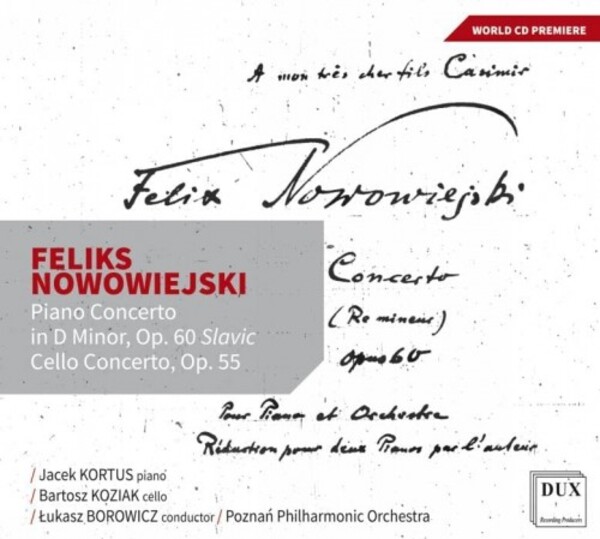
Nowowiejski - Piano Concerto, Cello Concerto
£14.20
In stock - available for despatch within 1 working day
Despatch Information
This despatch estimate is based on information from both our own stock and the UK supplier's stock.
If ordering multiple items, we will aim to send everything together so the longest despatch estimate will apply to the complete order.
If you would rather receive certain items more quickly, please place them on a separate order.
If any unexpected delays occur, we will keep you informed of progress via email and not allow other items on the order to be held up.
If you would prefer to receive everything together regardless of any delay, please let us know via email.
Pre-orders will be despatched as close as possible to the release date.
Label: Dux
Cat No: DUX1883
Format: CD
Number of Discs: 1
Genre: Orchestral
Release Date: 2nd June 2023
Contents
Artists
Jacek Kortus (piano)Bartosz Koziak (cello)
Poznan Philharmonic Orchestra
Conductor
Lukasz BorowiczWorks
Cello Concerto in E minor, op.55Piano Concerto in D minor, op.60 'Slavic'
Artists
Jacek Kortus (piano)Bartosz Koziak (cello)
Poznan Philharmonic Orchestra
Conductor
Lukasz BorowiczAbout
Written in 1938, the Cello Concerto is dedicated to the Polish cellist, Dezyderiusz Danczowski. The very extensive, three movement work is a very rare example of such a composition in the Polish music of the inter- war period. Stylistically, the piece belongs to "Slavic Modernism": it combines liltingness, lyricism, and inspiration drawn from the Slavic body of motifs with the symphonic accomplishments of Albert Roussel. Full use of the orchestra and monolithic tutti are juxtaposed with chamber moments (here, the influence of German Modernists, whose music Nowowiejski also followed very closely, is easily discernible).
Frequent dialogues between the soloist and instruments of the orchestra, as well as emancipation of individual instrumental groups make the work formally close to the sinfonia concertante that enjoyed enormous popularity in the works of neo-Classicist composers of the 1930s.
Bartosz Koziak, the soloist, performs the concerto on the instrument that once belonged to Dezyderiusz Danczowski, the piece's first performer.
The Piano Concerto was composed in 1941 and presents something of a sum of Nowowiejski's oeuvre: fascination with modernism, which imbues the Cello Concerto and Symphony no.2 (Praca i rytm - Labour and Rhythm), yields to the previous Slavic liltingness and the Neo-Romantic idiom.
The piano part, which in this Concerto presents itself in a truly imposing way, refers directly to the achievements of late- Romantic virtuosity. The formal structure brings to mind the classical form.
Error on this page? Let us know here
Need more information on this product? Click here